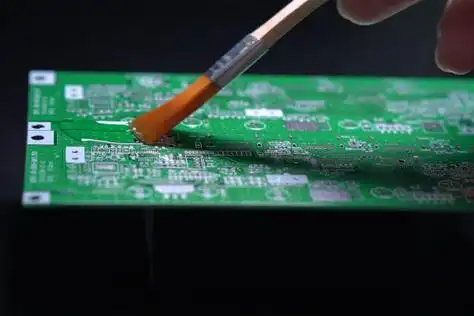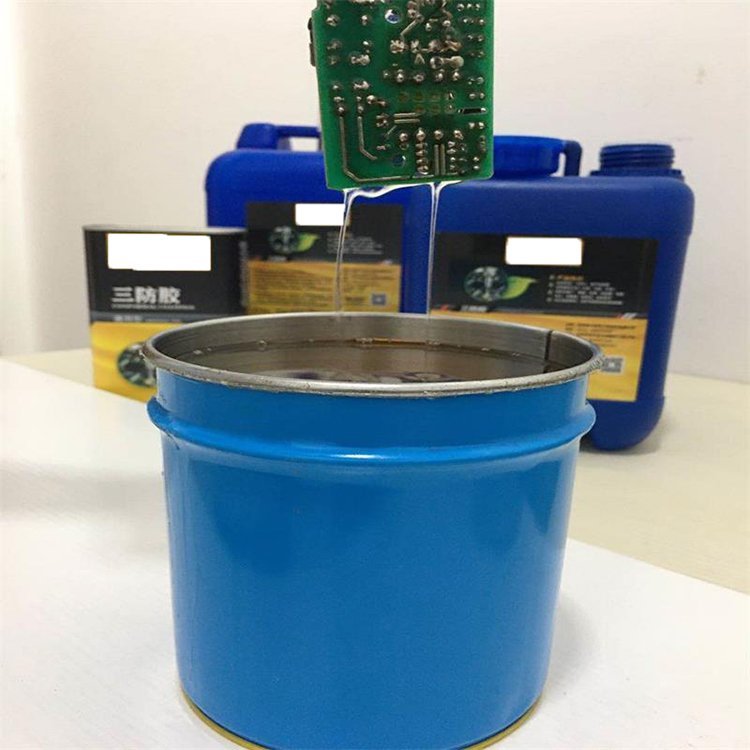Three-Proof Paint: Brush, Dip & Spray Coating Guide
 14 May 2025 17:19:05 GMT
PCBASAIL
14 May 2025 17:19:05 GMT
PCBASAIL
The Brush Coating Method in the Operation Process of Three-proof Paint
Introduction
The brush coating method is the simplest coating method. It is usually used for local repair and maintenance, and can also be used in laboratory environments or for small - batch trial production/production, generally in situations where the coating quality requirements are not very high.

Advantages
Advantages of the brush coating method: There is almost no need for investment in equipment fixtures; coating materials can be saved; there is generally no need for the masking process.
Disadvantages
Disadvantages: Narrow application range; the lowest efficiency; there is a shielding effect when brushing the entire board, and the coating consistency is poor. Due to manual operation, defects such as air bubbles, ripples, and uneven thickness are likely to occur; a large amount of manpower is required.
Precautions
Before brush coating, it is necessary to ensure that the diluted product is fully stirred, and it is best to let it stand for 2 hours.
The container for holding the three - proof paint should be made of metal or plastic. Wood and PVC are not allowed because chemical reactions will occur, corroding the container and damaging the product. Clean and bake the board to remove moisture.
The surface of the object to be coated must have its dust, moisture, and oil completely removed. Thorough cleaning can ensure that the corrosive residues are completely removed and enable the three - proof paint to adhere well to the surface of the circuit board.
The selection of the brush is also very important. Since the product is not insulated before curing, an anti - static brush that does not shed bristles, such as a high - quality natural fiber brush, should be selected.
When brush coating, the board should be placed flat as much as possible. There should be no dripping after brush coating. The brush coating should be smooth, and there should be no exposed parts. It is appropriate to have a thickness between 0.1 - 0.3mm. The circuit board after brush coating should not be placed upside down, as this will make the coating thicker at the bottom and thinner at the top. It should still be placed flat.
The Dipping Coating Method in the Operation Process of Three - proof Paint
Introduction
The dipping coating method has been widely used from the initial stage of the coating process to the present, and is suitable for occasions where complete coating is required. In terms of the coating effect, the dipping coating method is one of the most effective methods.

Advantages
Advantages of the dipping coating method: It can be coated manually or automatically. Manual operation is simple and easy, with small investment; the material transfer rate is high, and the entire product can be completely coated without a shielding effect; automated dipping coating equipment can meet the needs of mass production.
Disadvantages
Disadvantages of the dipping coating method: If the container for the coating material is open, with the increase in the number of coating times, there will be impurity problems. It is necessary to regularly replace the material and clean the container, and the solvent also needs to be continuously replenished; the coating thickness is too large, and a lot of material will be wasted due to dripping after the circuit board is drawn out; the corresponding parts need to be masked; a large amount of manpower and material resources are required for masking/removing the masking; it is difficult to control the coating quality, resulting in poor consistency; excessive manual operation may cause unnecessary physical damage to the product.
Key points
Key points of the dipping coating method: The loss of the solvent should be monitored at any time with a densitometer to ensure a reasonable ratio; the dipping and drawing speeds should be controlled to obtain a satisfactory coating thickness and reduce defects such as air bubbles; the operation should be carried out in a clean environment with controlled temperature and humidity to avoid affecting the bonding force of the material; an anti - static masking tape without residual adhesive should be selected. If a common tape is selected, a deionized blower must be used.
Precautions
For the circuit board assembly, it should be vertically immersed in the coating tank.
The connector should not be immersed, unless it is carefully masked. The circuit board should be immersed for 1 minute until the air bubbles disappear, and then taken out slowly.
A uniform film layer will be formed on the surface of the circuit board. Most of the coating residues should be allowed to flow back into the dipping machine from the circuit board.
The immersion speed of the circuit board or components should not be too fast to avoid generating too many bubbles.
When using it again after the dipping coating is completed, if there is a skin formation on the surface, the skin should be removed and it can be used continuously.
Spraying Process Flow of Three - proof Paint for PCBA
1. Required Tools
Three - proof paint, paint container, rubber gloves, mask or respirator, brush, masking tape, tweezers, ventilation equipment, drying rack, oven.
2. Spraying Steps
Brush surface A → Surface dry → Brush surface B → Curing at room temperature
3. Coating Requirements
Clean and bake the board to remove moisture. The dust, moisture and oil on the surface of the object to be coated must be completely removed so that the three - proof paint can fully exert its protective effect. Thorough cleaning can ensure that the corrosive residues are completely removed, and the three - proof paint can adhere well to the surface of the circuit board. Baking conditions: 60°C, 10 - 20 minutes. It is better to apply the paint while it is hot after taking it out of the oven.
When coating the three - proof paint by brushing, the brushing area should be larger than the area occupied by the devices to ensure that all devices and pads are fully covered.
When brushing the three - proof paint, the circuit board should be placed flat as much as possible. There should be no dripping after brushing. The brushing should be smooth, and there should be no exposed parts. It is appropriate that the thickness is between 0.1 - 0.3mm.
Before brushing and spraying the three - proof paint, ensure that the diluted three - proof paint is fully stirred, and let it stand for 2 hours before brushing or spraying. Use a high - quality natural fiber brush to gently brush or dip - coat at room temperature. If using machinery, measure the viscosity of the paint (using a viscometer or flow cup), and use a diluent to adjust the viscosity.
The circuit board assembly should be vertically immersed in the paint tank. The connector should not be immersed unless it is carefully masked. The circuit board should be immersed for 1 minute until the bubbles disappear, and then taken out slowly. A uniform film layer will be formed on the surface of the circuit board. Most of the paint residues should be allowed to flow back into the dipping machine from the circuit board. Different TFCF has different coating requirements. The immersion speed of the circuit board or components should not be too fast to avoid generating too many bubbles.
When using it again after the dipping coating is completed, if there is a skin formation on the surface, remove the skin and it can be used continuously.
After brushing, place the circuit board flat on the support and prepare for curing. Use the method of heating to accelerate the curing of the coating. If the surface of the coating is uneven or contains bubbles, when putting it into the high - temperature furnace for curing, it should be placed at room temperature for more time to allow the solvent to flash off.
4. Precautions
During the spraying process, some components cannot be sprayed, such as high - power components with heat dissipation surfaces or radiators, power resistors, power diodes, cement resistors, DIP switches, adjustable resistors, buzzers, battery holders, fuse holders (tubes), IC sockets, tactile switches, etc.
It is prohibited to pour the remaining three - proof paint back into the original storage container. It should be stored separately and airtightly.
If the workshop or storage room has not been opened for a long time (more than 12 hours), it should be ventilated for 15 minutes before entering.
If the paint accidentally splashes into the eyes, immediately open the upper and lower eyelids, rinse thoroughly with flowing water or normal saline, and then seek medical treatment.